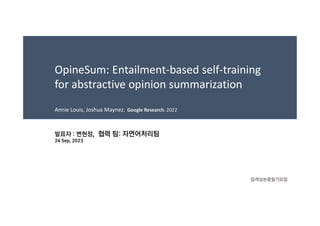
OpineSum Entailment-based self-training for abstractive opinion summarization_변현정.pdf
- 1. OpineSum: Entailment-based self-training for abstractive opinion summarization Annie Louis, Joshua Maynez, Google Research. 2022
- 3. Introduction • OpineSum Abstractive Opinion summarization : Entailment-base self-training Textual entailment and capture the consensus of opinions Train both unsupervised and few-shot learning
- 4. • Unsupervised neural networks Auto-encoder : input data Encoder Focus VAEs(Variation Auto Encoders) : Generate Decoder • Self-training methods • Unlabeled data features, auto labeling, pretraining and fine-tunning • Few-shot learning : k-way n-shot , Similarity learning Related Work
- 5. • Defining review consensus find out how often the collection supports the proposition, • Extracting propositions split review sentences into propositions and use our key units • Scoring consensus , , proposition • Silver summaries MMR(Maximal Marginal Relevance) Textual entailment to identify consensus
- 6. Consensus opinion • Consensus or common opinion the SPACE corpus ( on TripAdvisor.com) “location is right across balboa park” : summary-worthy one * create our silver-standard data
- 7. Consensus opinion • Consensus or common opinion Same claim may be expressed “This hotel is in the heart of Times Square ” , ‘Hotel’s location is slap bang in the middle of Times Square.’ “The fishis tasty” and ‘The salmon is delicious’
- 8. Consensus opinion • Extracting propositions Long review sentences : contain a bunch of different claims -> split sentences into propositions : as a ‘single claim or fact’ (* conjunctions, period, and comma subject to a length of four)
- 9. Consensus opinion • Scoring consensus the M propositions • textual entailment rela on as P → H (P is a premise and H is a hypothesis) BERT-large : [CLS] Token (a linear layer to predict three classes: entailment, contradiction and neutral) Apache Beam1 pipeline review proposition
- 10. Consensus opinion • Silver summaries • decreasing order of their scores S(mi) • take the top n as the silver summary sentences • edundancy removal technique : MMR (maximal marginal relevance) Highest scoring proposition
- 11. Consensus opinion • Silver summaries • P1 was extracted from R2 • P2 from R4
- 13. • Dataset Unlabelled review corpus Evaluation dataset containing with human summaries SPACE-unlabeled : 1.1 million reviews for 11,000 hotels SPACE-eval : human generated summaries for a smaller set of 50 hotels • Models T5 (Text-to-Text Transfer Transformer) Pre-trained encoder-decoder models based on T5’s framework LongT5 : polynomial scale relationship to input length Experiments
- 14. • Evaluation Silver Data (as SPACE-OpineSum) : the unlabelled review corpus • SPACE items with a minimum of 50 reviews (4,729 items) • Computed 1.3B entailment predictions Self-training • Unsupervised and few-shot learning abstractive summarization • Trained LongT5-Large (770M parameters) and LongT5-(Large, XL) • Compare these systems with prior unsupervised work in the SPACE-eval dataset • the ROUGE performance on the validation set Experiments
- 15. • Evaluation Few-shot Learning • SPACE-eval (25 total) : training set (15items) and validation set(10 items) • Reduced learning rate, 1/5th of the standard 1e−4 Experiments
- 16. Results OPINESUM system use self-training only
- 17. Results
- 18. Conclusion simple self-training approach both unsupervised and few-shot using the entailment weights (scores) of each proposition self-training models could serve as checkpoints